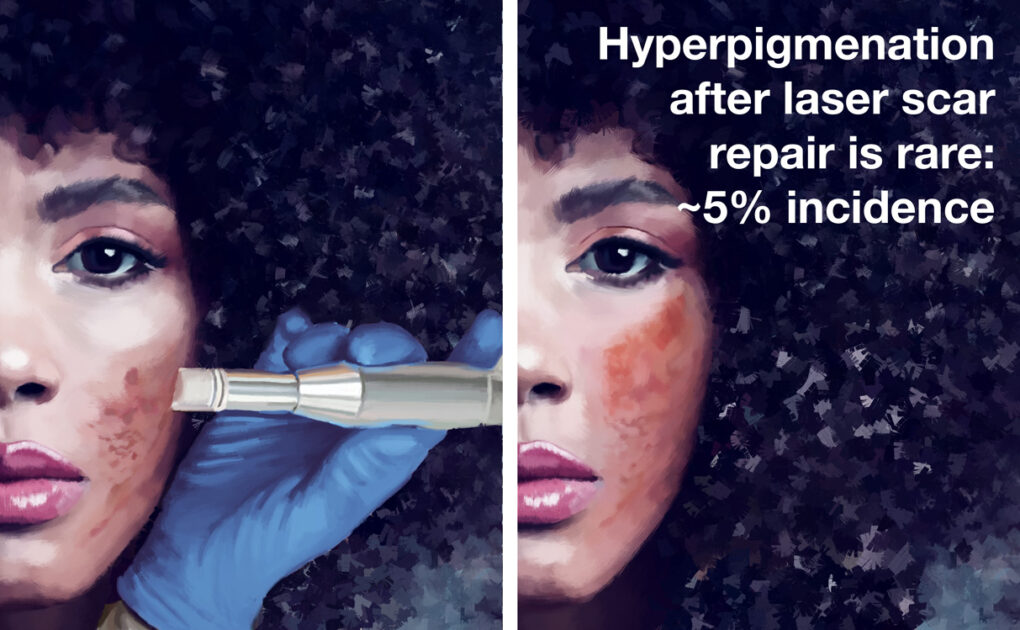About 5% of People Who Get Laser Scar Treatment Develop Temporary Hyperpigmentation

The Essential Info
Laser treatment can significantly improve the appearance of indented (atrophic) acne scars. Many different types of lasers are available, some requiring only one treatment session and others requiring as many as 6 sessions spaced out over multiple months. In general, stronger lasers produce results faster but also come with more downtime and a higher risk of side effects.
The development of dark marks (hyperpigmentation) is a side effect with many types of laser therapy, especially stronger laser therapy that is used specifically for acne scars. Studies show that hyperpigmentation from laser scar treatment occurs in about 5% of all patients, with darker-skinned (non-Caucasian) patients much more prone to this side effect than fair-skinned patients. Hyperpigmentation from laser therapy tends to be temporary and normally fades away on its own over time, but some people choose topical treatment to help reduce the dark marks.
Regardless of your skin type, take these precautions to reduce your risk of getting hyperpigmentation from laser treatment:
• Males and females: Avoid sun exposure and wear sunscreen for at least two weeks before and after your laser treatment
• Females: Avoid undergoing laser treatment close to or during your period

The Science
- The Research in a Nutshell
- What You Can Do to Lessen Your Chances of Developing Hyperpigmentation from Laser Therapy
- Risk of Hyperpigmentation for Each Laser Type
- The Research on Laser Acne Scar Treatment and Hyperpigmentation
- The Bottom Line
Laser therapy is the gold standard for treating acne scars–specifically, indented (atrophic) scars that look sunken-in. There is a wide range of lasers available for treating such scars. Generally, the lasers that produce the most dramatic results also come with the longest recovery time and the highest risk of side effects like the appearance of dark marks (hyperpigmentation) on the skin.
What exactly is a laser? A laser is a very strong beam of bright light.1
What is an atrophic acne scar? An indented scar develops when an acne lesion is so severe that it destroys the normal skin tissue in that spot. The skin tries to heal itself but is unable to regenerate enough cells to replace the damaged tissue. Therefore, the skin at the location of the scar ends up at a lower level compared to the rest of the skin and appears sunken-in.2
How does a laser help with acne scars? Because laser light is concentrated and intense, it causes controlled damage to the skin. The type and extent of the skin damage depends on the type of laser. This controlled damage triggers skin healing and/or regrowth, resulting in a smoother and more even skin surface. This is why laser scar treatment is sometimes called “laser resurfacing.”3
Most studies show significant improvement in the appearance of acne scars after laser therapy, ranging from 25% improvement to 75% or more.4-12 However, the efficacy of laser treatment varies across laser types.
One issue with laser therapy is the possibility of hyperpigmentation: the development of dark marks on the skin. People with naturally darker (non-Caucasian) skin are more prone to this side effect than lighter-skinned (Caucasian) people.
Lasers for treating acne scars tend to be some of the strongest lasers used in dermatology. As a result, they are effective but carry a higher risk of hyperpigmentation compared to, for example, the lasers used to treat acne itself. Let’s take a look what the research tells us about the chances of developing hyperpigmentation from laser scar treatment.
The Research in a Nutshell
Nine studies have looked at side effects of laser scar treatment, and if we add up the number of subjects in all of these studies, there are a total of 1,213 people who have participated. Out of these 1,213 people, hyperpigmentation occurred in 65 people, which amounts to about 5% of people.4-12 We should note that the participants in these studies spanned a wide range of skin types. In other words, this is likely to be a pretty reliable estimate of the average risk of getting hyperpigmentation from laser scar treatment. However, as we will see below, the risk does vary across different types of lasers.
If you decide to try laser scar treatment, you can reduce your risk of hyperpigmentation by taking a couple of precautions.
What You Can Do to Lessen Your Chances of Developing Hyperpigmentation from Laser Therapy
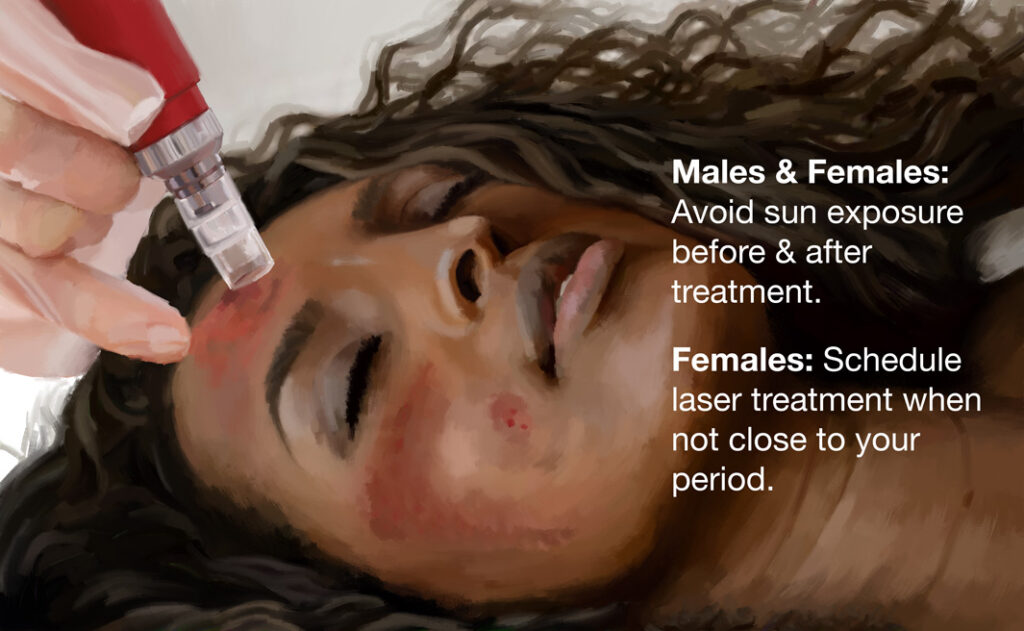
Regardless of your skin color, here is what you can do to reduce the likelihood of hyperpigmentation caused by laser scar treatment:
- Males and females: Avoid sun exposure before and after your laser treatment: Avoid extended sun exposure and wear broad-spectrum sunscreen for a minimum of two weeks before and after laser treatment to lower your risk of hyperpigmentation and to help hyperpigmentation fade more quickly if it does occur.13
- Females: Avoid scheduling laser treatment close to or during your period: Fluctuating hormone levels during menstruation stimulate increased production of the skin pigment melanin, temporarily making a woman’s skin darker. At this time in a woman’s cycle, she is at higher risk of hyperpigmentation from laser treatment.14-16
In addition, one study indicates that applying a steroid ointment to the skin for two days after laser therapy might help to lower the risk of hyperpigmentation.17 If you have dark skin and are worried about hyperpigmentation, feel free to ask your dermatologist about this option.
Your risk of developing hyperpigmentation from laser scar treatment will also depend on the specific type of laser your provider uses. Let’s take a look at how high the risk is for each of the available laser types.
Risk of Hyperpigmentation for Each Laser Type
Dermatologists can choose from a variety of laser types for acne scar treatment. The names of the lasers can be a little intimidating, but don’t worry, we’ll walk you through it.
Each type of laser typically has a name consisting of two parts:
- Wavelength: The first part of a laser’s name is a number between 500 and 11,000 that refers to the wavelength of light the laser emits, in nanometers (nm). Wavelengths between 500 and 760 nm correspond to different colors of visible light. In other words, we can see colored light emerging from these types of lasers. Wavelengths above 760 nm correspond to infrared light, which we cannot see but which can feel as heat.
- Material: The second part of a laser’s name is a word, or sometimes an acronym, that refers to the material(s) used to make the laser. Lasers can be created using glass, crystals, or gasses, and the specific material determines the wavelength of the laser light.
Below is a list of lasers used for acne scar treatment. In the first column, we give the name of each type of laser, and in the second column, we unpack what the name means. The last column shows the risk of getting hyperpigmentation from each laser based on the research evidence available to date.4-12 We should note that the vast majority of patients who developed hyperpigmentation in studies were those with darker (non-Caucasian skin).
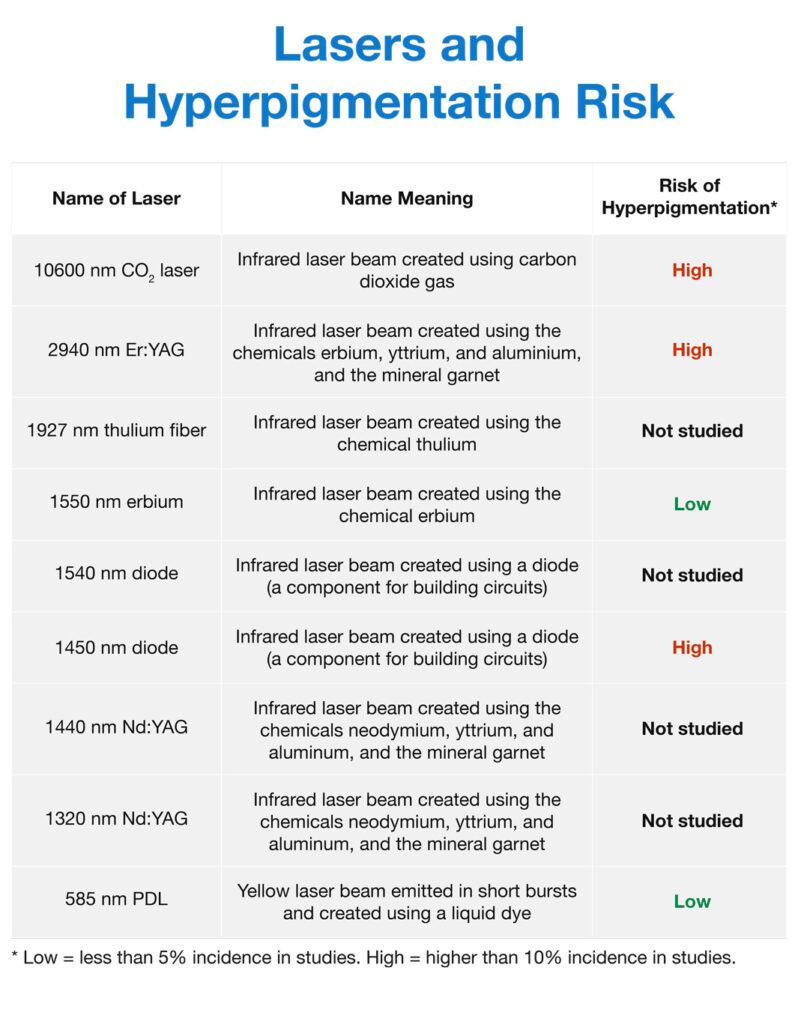
*Low = less than 5% incidence in studies. Medium = 5-10% incidence in studies. High = higher than 10% incidence in studies.
Types of lasers used for treating acne scars: The full scoop
All the lasers for treating acne scars fall into two major classes:
- Ablative (skin-removing) lasers: “Ablative” means “removing,” so these lasers literally remove skin. Ablative lasers work by quickly heating up water molecules in the epidermis (the upper layer of the skin), which basically “vaporizes” this skin layer. Because ablative lasers completely remove the epidermis and stimulate it to regrow, they can achieve dramatic results, but they also come with a long recovery time and a relatively high risk of side effects like hyperpigmentation.
- Non-ablative (non-skin-removing) lasers: These lasers work by causing a controlled injury in the dermis (the deep layer of the skin). This triggers skin remodeling and the formation of new collagen, the protein that makes our skin supple, in the dermis. Because non-ablative lasers cause the skin to slowly reshape itself from the inside, the results they achieve are more gradual and moderate compared to ablative lasers, but they offer the advantages of a short recovery time and a relatively low risk of side effects.3
Both ablative and non-ablative lasers can come in either of two forms:
- Non-fractional lasers: These older lasers target the whole skin surface in a particular area without leaving any gaps. Since an entire section of skin is damaged, healing time is longer than with fractional lasers.
- Fractional lasers: These newer lasers deliver many small pinpoints of laser light in a grid-like pattern, so that areas of skin in-between the pinpoints are left untouched. Since only a small portion of the skin is damaged, healing time is shorter compared to non-fractional lasers.3,18
The table below shows the risk of hyperpigmentation with each of the four major classes of lasers.
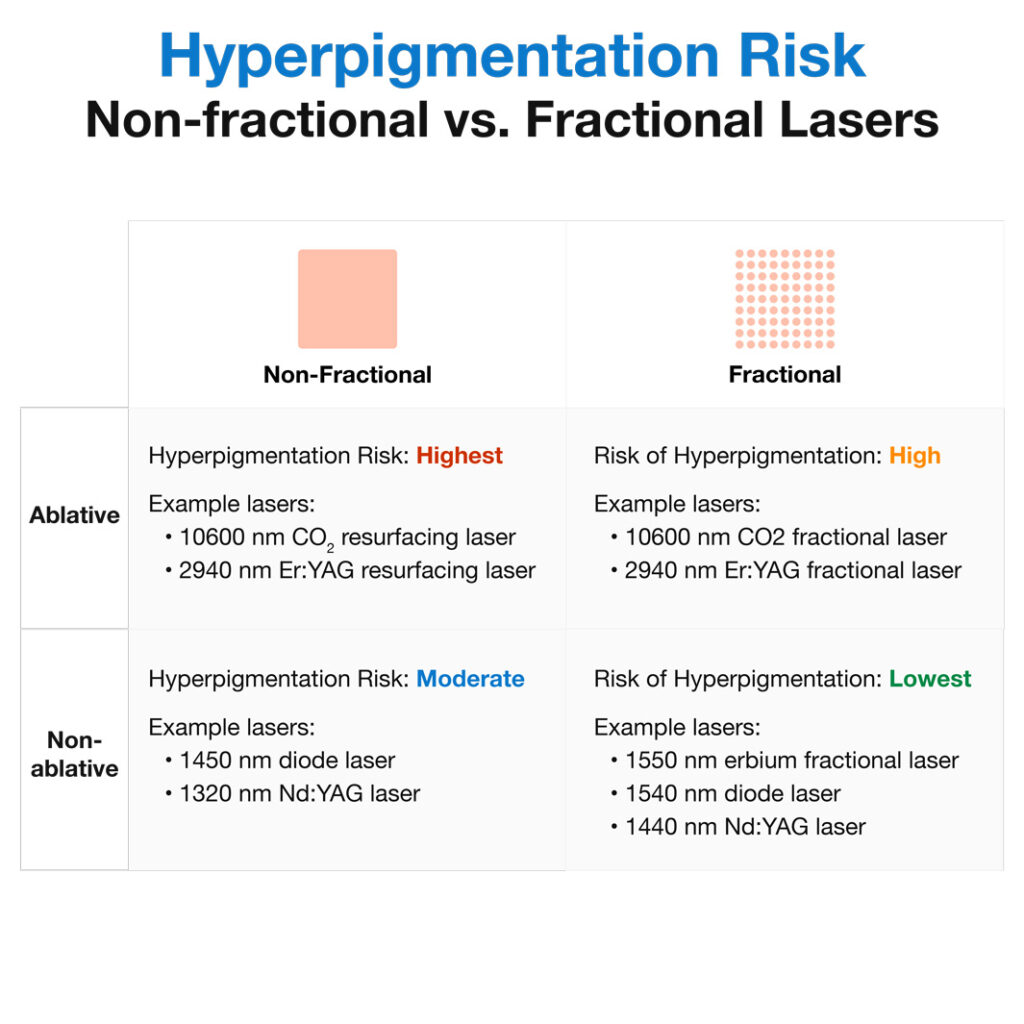
If you want to know more about the studies that have tested laser treatment on people with acne scars, including their conclusions on efficacy and the chances of hyperpigmentation, keep reading and we’ll give you the full story.
The Research on Laser Acne Scar Treatment and Hyperpigmentation
Since the risk of hyperpigmentation depends on skin color, researchers use a system for noting down the skin color of their study participants. This system is called the Fitzpatrick scale. Let’s take a quick look.
The Fitzpatrick scale for skin color
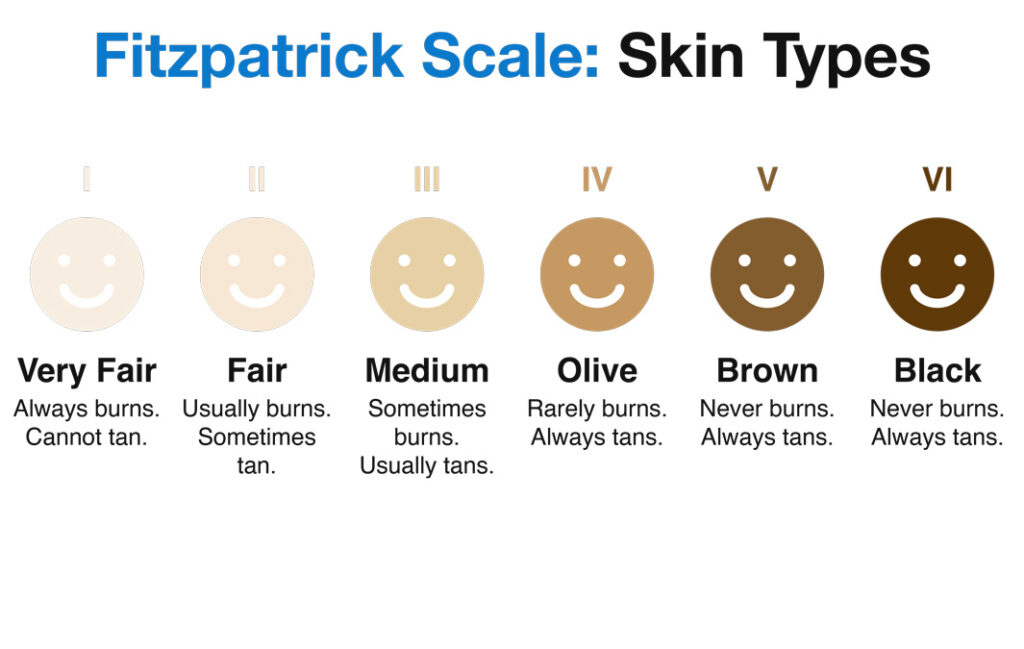
The Fitzpatrick scale assigns each person’s skin color a number from 1 to 6, in Roman numerals (I-VI), with 1 being the fairest and 6 being the darkest skin. This allows researchers to easily compare the skin color of participants across different studies.
Now let’s dive into the research and look at studies on each laser type one by one.
Studies on hyperpigmentation after acne scar treatment with the 10600 nm CO2 laser
Three studies have looked at how likely patients are to develop hyperpigmentation after acne scar treatment with the 10600 nm CO2 laser. Taken together, a total of 52 patients underwent the laser treatment. The patients’ skin types ranged between I and IV, but the majority of the patients had skin type IV.4,9,12
How effective was the laser treatment for scars? The three studies used different measures to report how effective the laser treatment was. However, it is clear that most patients in all three studies experienced moderately good results. For example, in the first study, all patients’ scars improved by more than 25%.4 In the second study, the depth of scars decreased by an average of 66.8%, which means the scars began to appear much less sunken-in.9 In the third study, researchers rated average scar improvement over 5 on a scale of 0 to 10.12
Who got hyperpigmentation? Out of a total of 52 patients in the three studies, 17 patients, which amounts to a third, developed hyperpigmentation. All of the patients who got hyperpigmentation had skin type IV.4,9,12 However, the hyperpigmentation was temporary. For example, the authors of the first study wrote, “One patient experienced post-therapy hyperpigmentation…which spontaneously resolved within 2 weeks.”4
This research suggests that the 10600 nm CO2 laser is quite likely to cause temporary hyperpigmentation, especially in people with skin type IV.
Expand to reveal more details of studies
The first study was published in 2009 in the Journal of the European Academy of Dermatology and Venereology.4 This study tested the fractional CO2 laser. The points below summarize key information about the study.
- Number of patients treated with this laser: 8
- Skin types of patients: IV
- Acne scar severity: Mild-to-severe atrophic scars
- Number of laser treatments: 1
- Frequency of laser treatments: Not applicable
- Acne scar improvement after laser: 26-50% improvement in 5 patients, 51-75% improvement in 2 patients, and over 76% improvement in 1 patient three months after treatment
- Hyperpigmentation after laser: 1 patient
The second study was published in 2008 in the journal Lasers in Surgery and Medicine.9 This study tested the fractional CO2 laser.
- Number of patients treated with this laser: 15
- Skin types of patients: I-IV
- Acne scar severity: Moderate-to-severe acne scars
- Number of laser treatments: 2-3
- Frequency of laser treatments: Once every 1-2 months
- Acne scar improvement after laser: An average of 66.8% improvement in scar depth
- Hyperpigmentation after laser: 0 patients
The third study was published in 2016 in the Journal of Plastic, Reconstructive & Aesthetic Surgery.12 This study tested both the non-fractional and fractional CO2 lasers.
- Number of patients treated with this laser: 17 with non-fractional laser and 12 with fractional
- Skin types of patients: IV
- Acne scar severity: Unknown
- Number of laser treatments: 1-3 for non-fractional laser, 2-4 for fractional laser
- Frequency of laser treatments: Once every 6-12 months for non-fractional laser, once every 2 months for fractional laser
- Acne scar improvement after laser: An average improvement of 6.0 on a scale of 0-10 (where 0 means no improvement and 10 means excellent improvement) for non-fractional laser; an average improvement of 5.2 for fractional laser
- Hyperpigmentation after laser: 80% of patients for non-fractional laser, 20% of patients for fractional laser
Studies on hyperpigmentation after acne scar treatment with the 2940 nm Er:YAG laser
Two studies have looked at how likely patients are to develop hyperpigmentation after acne scar treatment with the 2940 nm Er:YAG laser. Taken together, a total of 43 patients with skin types IV and V underwent the laser treatment.11,12
How effective was the laser treatment for scars? The two studies used different measures to report how effective the laser treatment was. However, it appears that most patients experienced moderately good results. For example, in the first study, 96% of patients saw at least fair improvement in their acne scars.11 In the second study, researchers rated average scar improvement 5.8 on a scale of 0 to 10.12
Who got hyperpigmentation? Out of a total of 43 patients in the three studies, 12 patients, or roughly a quarter, developed hyperpigmentation. We should note that all the patients in these studies had relatively dark skin.11,12 The hyperpigmentation was temporary. The authors of the first study wrote, “Post-treatment pigmentation was seen only in 2% [of treatment sessions] and was effectively treated with demelanizing creams.”11
This research suggests that the 2940 nm Er:YAG laser is quite likely to cause temporary hyperpigmentation, especially in people with relatively dark (non-Caucasian) skin.
Expand to reveal more details of studies
The first study was published in 2013 in the Indian Journal of Dermatology, Venereology, and Leprology.11 This study tested the fractional Er:YAG laser. The points below summarize key information about the study.
- Number of patients treated with this laser: 25
- Skin types of patients: IV-V
- Acne scar severity: Unknown
- Number of laser treatments: 4
- Frequency of laser treatments: Once a month
- Acne scar improvement after laser: 96% of patients experienced at least fair improvement
- Hyperpigmentation after laser: 2% of treatment sessions
The second study was published in 2016 in the Journal of Plastic, Reconstructive & Aesthetic Surgery.12 This study tested the non-fractional Er:YAG laser.
- Number of patients treated with this laser: 18
- Skin types of patients: IV
- Acne scar severity: Unknown
- Number of laser treatments: 1-2
- Frequency of laser treatments: Once every 6-12 months
- Acne scar improvement after laser: An average improvement of 5.8 on a scale of 0-10 (where 0 means no improvement and 10 means excellent improvement)
- Hyperpigmentation after laser: 60% of patients
Studies on hyperpigmentation after acne scar treatment with the 1550 nm erbium laser
Five studies have looked at how likely patients are to develop hyperpigmentation after acne scar treatment with the 1550 nm erbium laser. Taken together, a total of 1,078 patients with skin types I-V underwent the laser treatment.4,7,8,10,12
How effective was the laser treatment for scars? All the studies used different measures to report how effective the laser treatment was. In addition, one study only looked at side effects and did not evaluate efficacy. In the remaining studies, it appears that most patients experienced modest to moderate results. For example, in the first study, all but one patient experienced at least a 26% improvement in the appearance of their scars.4 In another study, the researchers rated the average improvement a 2.2 on a scale of 0-10, where 0 means no improvement and 10 means excellent improvement.12
Who got hyperpigmentation? Out of a total of 1,078 patients in the five studies, 17 patients, or less than 2%, developed hyperpigmentation. 4,7,8,10,12 The authors of the largest study analyzed which skin types tended to get hyperpigmentation, and found that the risk was highest for skin type V, followed by skin types IV and III.10 Considering that skin type V was the darkest skin type in all these studies, this tells us that the darker your skin, the higher your risk of hyperpigmentation from the erbium laser. The authors of one study noted that the hyperpigmentation disappeared within 2 weeks.4
This research suggests that the 1550 nm erbium laser is not very likely to cause hyperpigmentation, but your risk is higher if you have darker (non-Caucasian) skin.
Expand to reveal more details of studies
The first study was published in 2009 in the Journal of the European Academy of Dermatology and Venereology.4 This study tested the erbium-glass laser. The points below summarize key information about the study.
- Number of patients treated with this laser: 8
- Skin types of patients: IV
- Acne scar severity: Mild-to-severe atrophic scars
- Number of laser treatments: 1
- Frequency of laser treatments: Not applicable
- Acne scar improvement after laser: 26-50% improvement in 6 patients, 51-75% improvement in 1 patient, and minimal to no improvement in 1 patient three months after treatment
- Hyperpigmentation after laser: 1 patient
The second study was published in 2011 in the journal Lasers in Surgery and Medicine.7 This study tested the fractional erbium-doped fiber laser.
- Number of patients treated with this laser: 45
- Skin types of patients: III-V
- Acne scar severity: Unknown
- Number of laser treatments: 4-6
- Frequency of laser treatments: Once a month
- Acne scar improvement after laser: 35% of patients attained improvement of over 50%
- Hyperpigmentation after laser: 17% of patients
The third study was published in 2007 in the Journal of Dermatologic Surgery.8 This study also tested the fractional erbium-doped fiber laser.
- Number of patients treated with this laser: 53
- Skin types of patients: I-V
- Acne scar severity: Mild-to-moderate atrophic acne scars
- Number of laser treatments: 1-3
- Frequency of laser treatments: Once every 4 weeks until patients were satisfied with results
- Acne scar improvement after laser: 91% of patients experienced at least 25% improvement in scar appearance after one treatment; 87% of patients experienced at least 51% improvement after 3 treatments
- Hyperpigmentation after laser: 1 patient with skin type V
The fourth study was published in 2008 in the Journal of Dermatologic Surgery.10 This study tested the fractional erbium-doped laser.
- Number of patients treated with this laser: 961
- Skin types of patients: I-V
- Acne scar severity: Unknown
- Number of laser treatments: Unknown
- Frequency of laser treatments: Unknown
- Acne scar improvement after laser: Unknown–study only evaluated side effects, not efficacy
- Hyperpigmentation after laser: 0.73% of patients, mostly skin types III-V
The fifth study was published in 2016 in the Journal of Plastic, Reconstructive & Aesthetic Surgery.12 This study tested the fractional erbium-doped fiber laser.
- Number of patients treated with this laser: 11
- Skin types of patients: IV
- Acne scar severity: Unknown
- Number of laser treatments: 1-5
- Frequency of laser treatments: Once every 3 weeks
- Acne scar improvement after laser: An average improvement of 2.2 on a scale of 0-10 (where 0 means no improvement and 10 means excellent improvement)
- Hyperpigmentation after laser: 10% of patients
Study on hyperpigmentation after acne scar treatment with the 1450 nm diode laser
One study has looked at how likely patients are to develop hyperpigmentation after acne scar treatment with the 1450 nm diode laser. In this study, 30 patients with skin types II-IV underwent the laser treatment.6
How effective was the laser treatment for scars? Only about half of the cases showed improvement that the researchers rated as good or very good. About a third of patients, or 37%, saw little or no improvement in the appearance of their acne scars after the treatment.6
Who got hyperpigmentation? Twenty patients, which amounts to two-thirds, developed hyperpigmentation. The scientists noted that the hyperpigmentation appeared very quickly after the treatment session. They wrote, “It was more with [skin] types III and IV.”6
This research suggests that the 1450 nm laser is quite likely to cause temporary hyperpigmentation, especially in people with darker skin types. However, we should keep in mind that we only have one study on this laser type so far.
Expand to reveal more details of study
The study was published in 2005 in the Egyptian Dermatology Online Journal.6 The points below summarize key information about the study.
- Number of patients treated with this laser: 30
- Skin types of patients: II-IV
- Acne scar severity: Unknown
- Number of laser treatments: 4-6
- Frequency of laser treatments: Once every 3 weeks
- Acne scar improvement after laser: No improvement in 23.3% of patients, weak improvement in 13.3%, fair improvement in 10%, good improvement in 33.3%, and very good improvement in 20%
- Hyperpigmentation after laser: 20 patients
Study on hyperpigmentation after acne scar treatment with the 585 nm PDL laser
One study has looked at how likely patients are to develop hyperpigmentation after acne scar treatment with the 585 nm PDL laser. In this study, 10 patients with skin types I-IV underwent the laser treatment.5
How effective was the laser treatment for scars? The researchers measured the patients’ acne scars before and after laser treatment, and found that the treatment reduced their depth by about half on average.5 In other words, the scars began to look much less sunken-in.
Who got hyperpigmentation? None of the patients developed hyperpigmentation.5
This research suggests that the 585 nm laser is unlikely to cause hyperpigmentation. However, we must keep in mind that we only have one small study on this laser so far.
Expand to reveal more details of study
The study was published in 2002 in the Journal of Dermatologic Surgery.5 The points below summarize key information about the study.
- Number of patients treated with this laser: 10
- Skin types of patients: I-IV
- Acne scar severity: Unknown
- Number of laser treatments: 1
- Frequency of laser treatments: Not applicable
- Acne scar improvement after laser: Scar depth decreased by 47.8%. Researchers rated average improvement as 2.9 out of a maximum of 4.
- Hyperpigmentation after laser: 0 patients
The Bottom Line
About 5% of patients who undergo laser treatment for acne scars develop temporary dark marks (hyperpigmentation) on the skin. You are more likely to fall into this group if you have darker (non-Caucasian) skin, but you can lower your risk by selecting a gentler laser, such as the 1550 nm erbium laser or the 585 nm PDL laser. It is also important to wear sun protection for at least two weeks before and after your laser treatment, and for females, to avoid scheduling your laser appointment close to your period.
References
- Pei, S., Inamadar, A. C., Adya, K. A. & Tsoukas, M. M. Light-based therapies in acne treatment. Indian Dermatol. Online J. 6, 145–57 (2015).
- Vejjabhinanta, V., Patel, S. S. & Nouri, K. Laser for Scars. in Lasers in Dermatology and Medicine 45–51 (Springer London, 2011). doi:10.1007/978-0-85729-281-0_4
- Zuzul, K. The use of lasers in dermatology. (University of Zagreb, 2018). doi:10.2351/1.5057951
- Cho, S. et al. Non-ablative 1550-nm erbium-glass and ablative 10 600-nm carbon dioxide fractional lasers for acne scars: a randomized split-face study with blinded response evaluation. J. Eur. Acad. Dermatology Venereol. 24, 921–925 (2009).
- Patel, N. & Clement, M. Selective Nonablative Treatment of Acne Scarring With 585 nm Flashlamp Pulsed Dye Laser. Dermatologic Surg. 28, 942–945 (2002).
- Rasheed, A. I. Non-ablative Diode Laser for The Treatment of Post Acne Scars. Egypt. Dermatology Online J. 1, 1–9 (2005).
- Alajlan, A. M. & Alsuwaidan, S. N. Acne scars in ethnic skin treated with both non-ablative fractional 1,550 nm and ablative fractional CO2 lasers: Comparative retrospective analysis with recommended guidelines. Lasers Surg. Med. 43, 787–791 (2011).
- Alster, T., Tanzi, E. & Lazarus, M. The Use of Fractional Laser Photothermolysis for the Treatment of Atrophic Scars. Dermatologic Surg. 33, 295–299 (2007).
- Chapas, A. M. et al. Successful treatment of acneiform scarring with CO2 ablative fractional resurfacing. Lasers Surg. Med. 40, 381–386 (2008).
- Graber, E. M., Tanzi, E. L. & ALSTER, T. S. Side Effects and Complications of Fractional Laser Photothermolysis: Experience with 961 Treatments. Dermatologic Surg. 34, 301–307 (2008).
- Pai, S. et al. Efficacy and safety of Erbium-doped Yttrium Aluminium Garnet fractional resurfacing laser for treatment of facial acne scars. Indian J. Dermatology, Venereol. Leprol. 79, 193 (2013).
- You, H.-J., Kim, D.-W., Yoon, E.-S. & Park, S.-H. Comparison of four different lasers for acne scars: Resurfacing and fractional lasers. J. Plast. Reconstr. Aesthetic Surg. 69, e87–e95 (2016).
- Pai, G. S. & Pai, A. H. Q-Switched Laser Treatment for Freckles in Individuals with Skin Type V. Aesthet. Dermatology Surg. 1, 2–7 (2017).
- Al Mohizea, S. The effect of menstrual cycle on laser induced hyperpigmentation. J. drugs dermatology 12, 1335–6 (2013).
- Snell, R. S. & Turner, R. Skin Pigmentation in Relation to the Menstrual Cycle. J. Invest. Dermatol. 47, 147–155 (1966).
- Nanni, C. A. & Alster, T. S. Complications of carbon dioxide laser resurfacing. An evaluation of 500 patients. Dermatologic Surg. 24, 315–20 (1998).
- Cheyasak, N., Manuskiatti, W., Maneeprasopchoke, P. & Wanitphakdeedecha, R. Topical Corticosteroids Minimise the Risk of Postinflammatory Hyperpigmentation After Ablative Fractional CO2 Laser Resurfacing in Asians. Acta Derm. Venereol. 95, 201–205 (2015).
- Preissig, J., Hamilton, K. & Markus, R. Current Laser Resurfacing Technologies: A Review that Delves Beneath the Surface. Semin. Plast. Surg. 26, 109–16 (2012).
 Acne.org Products
Acne.org Products